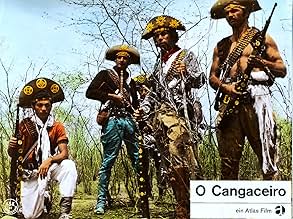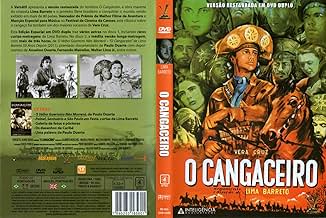अपनी भाषा में प्लॉट जोड़ें'Capitão', a bandit, terrorizes poor villages in the Northeast region of Brazil, looting and frequently killing with his armed gang, until he kidnaps and becomes attracted to a beautiful sch... सभी पढ़ें'Capitão', a bandit, terrorizes poor villages in the Northeast region of Brazil, looting and frequently killing with his armed gang, until he kidnaps and becomes attracted to a beautiful schoolteacher, creating discord in his group.'Capitão', a bandit, terrorizes poor villages in the Northeast region of Brazil, looting and frequently killing with his armed gang, until he kidnaps and becomes attracted to a beautiful schoolteacher, creating discord in his group.
- पुरस्कार
- 2 जीत और कुल 1 नामांकन
फ़ीचर्ड समीक्षाएं
10elmar5
I saw this movie as an adolescent in the 60es just once on TV, but it still is one of only a handful which surface at least once every five years. As other reviewers have pointed out before, the great music by Zé do Norte was a major factor for this memorability. Foremost here is the ballad "Mulher Rendeira" (The Lacemaker), especially in the unforgettable scene when the gang rides in a duck line along a ridge which is set against the dusk sky and the gloomy grandeur of the Brazilian Sertao. In their leather garments, pepped up by the symbolism of amulets and talismans, the bandidos in this movie resemble an archaic tribe living in this land of dust and thorns for eons already. The movie is filmed in black and white which is lending it a certain kind of credibility reminding of a documentary. Although presenting a different plot, Barreto's movie was obviously inspired by the fate of the most famous couple of Brazilian cangaceiros, Lampiao and his wife Maria Bonita, who were killed in 1938 with seven others of their gang by the police.
10joel-280
Like the few great sci-fi, western, and other genre films, O Cangaceiro transcends its genre to speak of integrity and how people deal with awful contradictions and dilemmas that develop in their lives. Sometimes unsuccessfully.
But don't let my fancy talk deter you; it's a great movie and if somehow you have a chance to see it, don't miss it. It is a three-star attraction (meaning, "worth a trip.")
To meet the IMDb's length requirement, I'll also note its poetic photography, deservedly famous background music, and the cool, restrained treatment (aided by the b&w photography) of deep emotions and tragic events.
But don't let my fancy talk deter you; it's a great movie and if somehow you have a chance to see it, don't miss it. It is a three-star attraction (meaning, "worth a trip.")
To meet the IMDb's length requirement, I'll also note its poetic photography, deservedly famous background music, and the cool, restrained treatment (aided by the b&w photography) of deep emotions and tragic events.
In the times of the "cangaceiros" in the "sertão" (backcountry) in the North and Northeastern of Brazil, the cruel Capitão Galdino Ferreira (Milton Ribeiro) and his band abduct the school teacher Olívia (Marisa Prado), expecting to receive a ransom for her. However, one of his men, Teodoro (Alberto Ruschel) falls in love and flees with her through the arid backcountry chased by the brigands.
Along their journey, Olívia also falls in love with Teodoro and proposes him to leave the countryside and move to the city. But Teodoro loves also his land and tells that he would like to die in the backcountry where he was born.
"O Cangaceiro" is one of the best films of the Brazilian Cinema and the best produced by the Companhia Cinematográfica Vera Cruz. This film was written and directed by Lima Barreto, with dialogs of Rachel de Queiroz and is inspired in the story of the brigand Lampião and his band (http://en.wikipedia.org/wiki/Lampi%C3%A3o). The awesome cinematography in black and white discloses a magnificent introduction with backlight in the marauders.
On 12 May 1953, "O Cangaceiro" won the Cannes Film Festival in the category Best Adventure. In the wonderful soundtrack, highlights "Olê Muié Rendeira", sung by Vanja Orico. In accordance with the Wikipedia, this film was distributed by Columbia Pictures and sold to eighty (80) countries. It was exhibited in France for five consecutive years in the movie theaters. My vote is ten.
Title (Brazil): "O Cangaceiro" ("The Brigand")
Along their journey, Olívia also falls in love with Teodoro and proposes him to leave the countryside and move to the city. But Teodoro loves also his land and tells that he would like to die in the backcountry where he was born.
"O Cangaceiro" is one of the best films of the Brazilian Cinema and the best produced by the Companhia Cinematográfica Vera Cruz. This film was written and directed by Lima Barreto, with dialogs of Rachel de Queiroz and is inspired in the story of the brigand Lampião and his band (http://en.wikipedia.org/wiki/Lampi%C3%A3o). The awesome cinematography in black and white discloses a magnificent introduction with backlight in the marauders.
On 12 May 1953, "O Cangaceiro" won the Cannes Film Festival in the category Best Adventure. In the wonderful soundtrack, highlights "Olê Muié Rendeira", sung by Vanja Orico. In accordance with the Wikipedia, this film was distributed by Columbia Pictures and sold to eighty (80) countries. It was exhibited in France for five consecutive years in the movie theaters. My vote is ten.
Title (Brazil): "O Cangaceiro" ("The Brigand")
Another great film that is characterised by a memorable music score. Not all films with great music are great films, but haunting or otherwise memorable scores are a feature of so many of the greatest films of all time - The Third Man, Jeux Interdits, High Noon, American Graffiti, most of the Kubrick opus, Who's Afraid of Virginia Woolf and probably any documentary adopting Philip Glass' minimalism (The Thin Blue Line and The Fog of War) being prominent examples. This is so even when the music is not original but simply selected and edited in from classical music, popular or folk songs, as appropriate and evocative. Bets are that you won't be able to get the title folk song of O Cangaceiro out of your head for some time after you've finished watching it - it seems to affect every viewer that way.
This is a film reminiscent of The Wages of Fear, in its portrayal of poverty and the brutality, especially towards women, traditionally endemic in South America. No wonder Claude Levi-Strauss entitled his seminal ethnographic work based on travels in South America "Tristes Tropiques".
I had been warned of the brutality of the horse-dragging scene in this film - yet I can only say that it pales into insignificance with the graphic closing horse-dragging scene of The Cowboys - when I guess John Wayne was, as his career closed, ever more drawn to reactionary law-and-order neanderthalism.
A melancholic film with great B/W cinematography and even better music, depicting that eternal South American atmosphere of brutality and tragic sadness. A rare film well worth watching.
This is a film reminiscent of The Wages of Fear, in its portrayal of poverty and the brutality, especially towards women, traditionally endemic in South America. No wonder Claude Levi-Strauss entitled his seminal ethnographic work based on travels in South America "Tristes Tropiques".
I had been warned of the brutality of the horse-dragging scene in this film - yet I can only say that it pales into insignificance with the graphic closing horse-dragging scene of The Cowboys - when I guess John Wayne was, as his career closed, ever more drawn to reactionary law-and-order neanderthalism.
A melancholic film with great B/W cinematography and even better music, depicting that eternal South American atmosphere of brutality and tragic sadness. A rare film well worth watching.
This film was the first brazilian production exhibited internationally after receive a prize of Best Music at a Cannes Film Festival. It was distributed accross the world by Columbia Pictures and was very successful at the box office.
I understand why foreign audiences still enjoy it, but for us brazilians it's very artificial when the hero leaves the semi arid background where the bandits live and penetrates a deep jungle to fight a jaguar etc, since those geographical regions are separated by hundred and hundred miles, like Arizona from Oregon. Anyway the music is amazing as the photography and the actor who plays captain Galdino ( Milton Ribeiro ). I believe that the main influence of director Lima Barreto was not the american westerns as most of people say, but the mexican films of Emilio Fernandez like "Enamorada". "O cangacero" is a good film, even if not not a great one and deserves the fame it has.
I understand why foreign audiences still enjoy it, but for us brazilians it's very artificial when the hero leaves the semi arid background where the bandits live and penetrates a deep jungle to fight a jaguar etc, since those geographical regions are separated by hundred and hundred miles, like Arizona from Oregon. Anyway the music is amazing as the photography and the actor who plays captain Galdino ( Milton Ribeiro ). I believe that the main influence of director Lima Barreto was not the american westerns as most of people say, but the mexican films of Emilio Fernandez like "Enamorada". "O cangacero" is a good film, even if not not a great one and deserves the fame it has.
क्या आपको पता है
- ट्रिवियाThe very first Brazilian film to compete at the Cannes Film Festival.
- कनेक्शनEdited into A Edição do Nordeste (2023)
टॉप पसंद
रेटिंग देने के लिए साइन-इन करें और वैयक्तिकृत सुझावों के लिए वॉचलिस्ट करें
विवरण
- चलने की अवधि
- 1 घं 45 मि(105 min)
- रंग
- ध्वनि मिश्रण
- पक्ष अनुपात
- 1.37 : 1
इस पेज में योगदान दें
किसी बदलाव का सुझाव दें या अनुपलब्ध कॉन्टेंट जोड़ें









